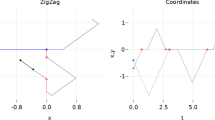Abstract
We consider a class of finite state, two-dimensional Markov chains which can produce a rich variety of patterns and whose simulation is very fast. A parameterization is chosen to make the process nearly spatially homogeneous. We use a form of pseudo-likelihood estimation which results in quick determination of estimate. Parameters associated with boundary cells are estimated separately. We derive the asymptotic distribution of the maximum pseudo-likelihood estimates and show that the usual form of the variance matrix has to be modified to take account of local dependence. Standard error calculations based on the modified asymptotic variance are supported by a simulation study. The procedure is applied to an eight-state permeability pattern from a section of hydrocarbon reservoir rock.
Similar content being viewed by others
References
Besag, J. E. (1975) Statistical analysis of non-lattice data. The Statistician, 24, 179–95.
Besag, J. E. (1986) On the statistical analysis of dirty pictures. Journal of the Royal Statistical Society, B, 48, 259–79.
Comets, F. (1992) On consistency of a class of estimators for exponential families of Markov random fields on the lattice. The Annals of Statistics, 20, 455–68.
Craig, P. S. and Seheult, A. H. (1992) Mathematical description of the three-dimensional spatial Markov chain simulator. Consultancy report from Durham University to Atomic Energy Authority Petroleum Services.
Craig, P. S. and Seheult, A. H. (1993) Understanding the control parameters of spatial Markov chains. Consultancy report from Durham University to Atomic Energy Authority Petroleum Services.
Cressie, N. A. C. (1991) Statistics for Spatial Data, Wiley, New York.
Crowder, M. J. (1976) Maximum likelihood estimation for dependent observations. Journal of the Royal Statistical Society, B, 38, 45–53.
Fayers, F. J. and Hewett, T. (1992) A review of current trends in petroleum reservoir description and assessment of the impacts on oil-recovery. Advances in Water Resources, 15, 341–65.
Omre, H. (1994) Topics in spatial statistics. Scandinavian Journal of Statistics, 21, 289–343.
Parish, R. G., Wikramaratna, R. S., Craig, P. S. and Seheult, A. H. (1992) GEOS—a practical tool for reservoir characterisation. Society of Petroleum Engineers, 23737.
Qian, W. and Titterington, D. M. (1990) Parameter estimation for hidden Gibbs chains. Statistics and Probability Letters, 10, 49–58.
Qian, W. and Titterington, D. M. (1991) Multidimensional Markov chain models for image textures. Journal of the Royal Statistical Society, B, 53, 661–74.
Author information
Authors and Affiliations
Rights and permissions
About this article
Cite this article
Craig, P.S., Seheult, A.H. Pseudo-likelihood estimation for a class of spatial Markov chains. Stat Comput 6, 303–311 (1996). https://doi.org/10.1007/BF00140875
Issue Date:
DOI: https://doi.org/10.1007/BF00140875




